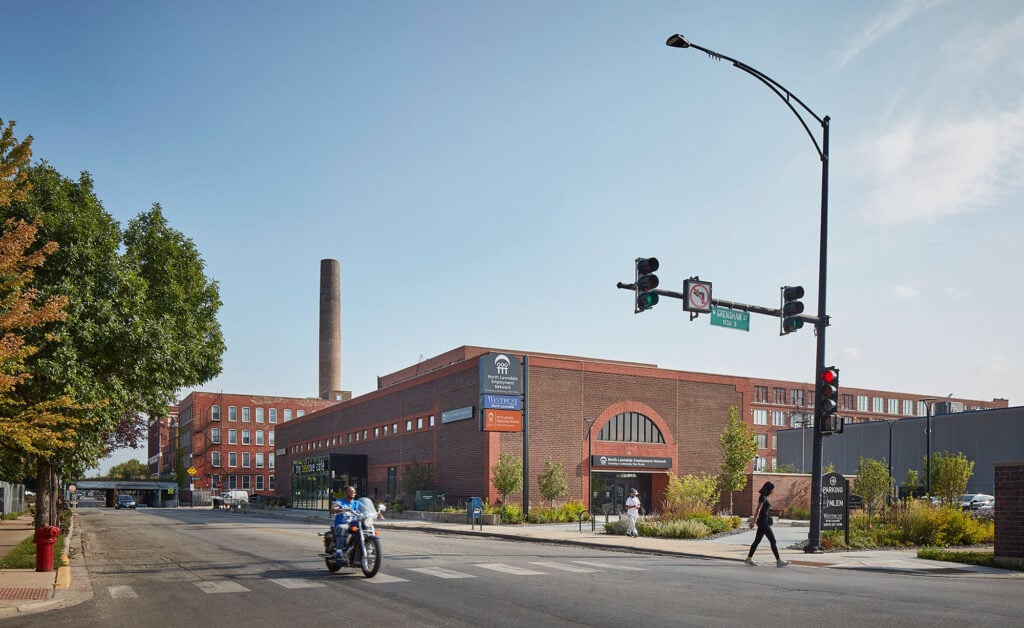
February 17, 2022
The North Lawndale Employment Network Sees Through Employment Barriers for the Formerly Incarcerated
“This campus was our first real footprint in the neighborhood, [It’s] a love-letter to the community.”
Brenda Palms Barber, founder of the North Lawndale Employment Network

Located in the former Community Bank of Lawndale (the first Black-owned bank in a neighborhood populated almost exclusively by Black people) this 1982 building designed by Ben Weese was something of an inauspicious beginning for NLEN. With its brick-bunker form and near absence of windows most notably defied by second-floor arched half-moons that nod absentmindedly in the direction of Postmodernism and Louis Sullivan’s National Farmer’s Bank, it didn’t appear particularly welcoming. The bank was “built like a fortress,” says Emmanuel Garcia, project architect at Wheeler Kearns, futilely attempting to ward away the poverty and precarity that surrounded it. But a fortress-like appearance doesn’t always guarantee stability, and Garcia and his team had to apply several structural fixes, repairing concrete masonry units and adding structural steel to exterior walls, even on one section of the building where the original bank vault was. (For his part, Weese eventually regretted the tossed-off Sullivan quotes, and that the building was built “crudely,” which he blamed on the contractor, according to the Chicago Architects Oral History Project.)


The most obvious change is the glass pavilion café—“The Bee Love Café”—added onto the building’s long western facade, where a thematic motif, the honeycomb hexagon, asserts itself in lighting installations and colorful decals. “It’s a quick and recognizable artifact, says Garcia. Here, Wheeler Kearns cut ground floor windows into the red-brick wall, as well as a pandemic-friendly pick-up window.
The building’s previous interior was organized as a large, open bank hall, but Wheeler Kearns’ adaptive reuse carefully subdivides the building to make space for many different functions. First and foremost is the Sweet Beginnings production space at its center. Around it huddles training and reception space, and a WinTrust bank branch. Windows in several of these satellite spaces look in on the production floor. “Where the bank hid its treasures away, NLEN celebrates their most important treasure—their clients,” says Garcia. Upstairs, there are office spaces, conference rooms, and informal meeting spaces.


Beyond its new administrative spaces, the most important elements of the Wheeler Kearns renovation make NLEN’s wider public mission legible to the community. In addition to a front courtyard, a walled peace garden adjacent to the building’s events center gives North Lawndale neighbors a soothing space to remember people lost to gun violence. Designed by Site Design Group, it features memorial plaques and pavers amid seating, shrubs, and trees. “We’ve lost so many people, and we wanted to create a place where people could just honor loved ones and have a quiet place where they could sit and reflect,” says Palms Barber. Before moving into the new NLEN headquarters, the organization was spread across five different sites. “This campus was our first real footprint in the neighborhood,” she says. “[It’s] a love-letter to the community.”

These added public spaces make NLEN more than just a place to learn new skills. They’re a step toward making a venue for rebinding people into the social fabric of the neighborhood. That’s been the experience of Joseph Smith, who’s been working at NLEN for nine years after being incarcerated because of a drug conspiracy charge. From his first beginning there, “it was like going to church,” he says. And today, “[it’s] my second home.” Wheeler Kearns’ NLEN is a clear-eyed assessment that intensely securitized design (even in places with relatively high crime) doesn’t do much but keep a building’s constituents at arm’s length. But this adaptive reuse makes it apparent that stability and support start with an open door and a way in.
Would you like to comment on this article? Send your thoughts to: [email protected]
Recent
Products
Jesús Llinares on Andreu World’s Path to Circular Design
The CEO of the Spanish furniture manufacturer speaks to METROPOLIS about the company’s history, approach to circularity, and recent research into bio-based materials.
Projects
New York Showcases the Next Generation of Flood Resiliency
At NYC’s new East River Park, Bjarke Ingels Group has debuted parts of its “BIG U”: an assemblage of green, gray, and social infrastructure.
Viewpoints
Designing a Regenerative World with Flax
Contemporary architects, designers, and engineers are transforming the ancient plant into low-carbon building materials and recyclable products.




